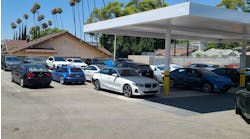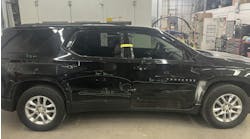Most drivers probably don’t give much thought to bumpers until they need to be repaired. The obvious damage is to the cover and often doesn’t look so bad. But the bumper system is far more than just the cosmetic cover.
Bumpers became standard equipment on cars in 1925. Early bumpers were simple metal bars. They served to protect the vehicle from damage when it “bumped” into things. Stylists worked to make them more attractive throughout the years. Curved, chrome-covered, metal bumpers were both stylish and durable. These solid metal bumpers were bolted directly to the end of the vehicle frame.
Not Just a Pretty Face
Safety First Evaluating bumper systems is not difficult, but it is more important than might be obvious to the casual observer. The cosmetic concerns are obvious. Deeper inspection should almost always be done to be certain all of the safety features are also addressed. When faced with an unfamiliar component design, be sure to check the vehicle manufacturer’s recommendations for damage inspection and replacement recommendations.
Modern bumpers systems include many parts that serve several purposes, the main one today being to provide protection to the vehicle’s occupants. They also still serve to protect the vehicle during low-speed impacts. Engineers are challenged to design an aesthetically pleasing, yet functional system that will not be excessively expensive to repair in minor collisions—or too heavy.
Federal standards for bumpers began in the 1970s. A property damage standard became effective in 1979, prohibiting damage except to bumpers and their attachments in 5 mph flat-barrier tests. That standard was later changed, and for 1983 and later vehicles it is now 2.5 mph. Further complicating the comprehension of this standard is that it was not applied to trucks. The line between passenger cars and trucks today has been blurred.
Low-speed impact performance is one function of bumper systems and is measured by how expensive “minor” impact repairs are. Since many accidents are low-speed—or parking lot—collisions, this is an important consideration. Complex plastic covers, lights housed inside the bumper, and very close integration with the hood and fenders, complicate repairs. The Insurance Institute for Highway Safety (IIHS) devotes time to studying low-speed bumper performance. Various tests performed by the IIHS demonstrate that minor impacts can cost a few hundred to several thousand dollars to repair, depending on how the bumper system is designed. More information on these tests can be found at www.hwysafety.org.
Four Major Parts
Bumper systems are made up of four elements: the cover, absorber, reinforcement bar and mounting system. These elements can be quite different from vehicle to vehicle, but the functions are the same. The cover is usually made of plastic and functions largely as a style element. Openings for air flow to the cooling system, housing for lights, and mounting for license tags may be designed in. Spoilers may be incorporated into the design or attached to the cover.
In low-speed impacts, the cover can bend and flex back. Behind the cover is an absorber. This part is made of plastic and is intended to collapse in minor impacts to absorb the energy. A rigid reinforcement bar, often called a re-bar, is located behind the absorber. The reinforcement is mounted to the frame rails. These mounts may be complex hydraulic devices designed to absorb minor impacts and rebound, simple metal mounts designed to bend and be replaced after minor impacts, or the end of the frame rail may serve as the mount.
In low-speed impacts, the bumper system absorbs energy by flexing the cover, crushing the absorber and collapsing the mounts. If the impact energy, which is a function of the mass of the vehicle and the speed of the impact, is low enough, this system will work and require minor repairs, such as replacing the absorber material, repairing any scratches to the cover, and painting.
High-Speed Impacts
During higher-speed collisions, the bumper system serves an entirely different purpose. The rigid reinforcement bar is the primary element in these instances. To protect the passengers, collision energy must be directed into areas of the vehicle that can dissipate the energy before it reaches the passenger area. A small portion of the energy is absorbed by the low-speed design aspects of the bumper system. After that, the collapse, or crush zones, of the frame rails must come into play. The most effective way to manage energy in a collision is if the two front frame rails can work together to use up the forces by bending and distorting. The job of the reinforcement is to direct the forces coming into the vehicle to both rails. When the impact is in the center of the vehicle that is obvious, but even in offset collisions, much of the energy can be directed to the other side if the reinforcement bar is sufficiently strong. This important function is why vehicle manufacturers do not approve of repairs to reinforcement bars.
Evaluating the Parts
When inspecting vehicles and writing estimates, how do we evaluate each of these parts? Bumper covers are the easy part. They are available for inspection, so most damage is readily visible. Plastic repair techniques can be applied to minor damages. More extensive damage may require replacement of the cover. Textured bumper covers will often require replacement.
The absorber material between the cover and reinforcement should be inspected in all but the most minor cover repair jobs. If the cover needs to be removed to facilitate the repair process, inspecting the absorber is easy. If not, R&I may need to be considered just for the purpose of inspecting this important part.
With minor exceptions, manufacturers do not approve of repairing absorbers. General Motors Corp. approves of gluing simple, small cracks, if there isn’t any crushed material. Molded honeycomb styles may be reshaped in areas outside of the frame rail mounting if the plastic is not torn. This is done with a small amount of heat to soften the plastic. However, most damage to absorbers will require replacement.
Reinforcement bars are a critical safety part. Manufacturers are very clear that the only repairs approved are cold bending of mounting tabs. Because of the function they serve, any weakening of the part could result in compromised occupant safety.
Reinforcements may be made of steel, usually ultra high-strength steel (UHSS), high-strength aluminum, or composites. UHSS and high-strength aluminum are so stiff they cannot be bent without causing microscopic cracks. They are heat-treated and cannot be heated to ease repairs. And they cannot be welded on unless the vehicle manufacturer allows it, as on some Corvettes. Composite reinforcements are formed under heat and pressure and are not easily repaired.
Manufacturers have chosen to prohibit repairs. When inspecting composite reinforcement bars, any cracks or changes in shape will require replacement. However, composite bars will occasionally have white fiberglass fibers on the surface. These are the result of the manufacturing process but may be mistaken for a crack.
Mounting systems have also evolved throughout the years. When the federal bumper standards were first enacted, manufacturers designed complex machines to absorb impact forces. There were sliding tubes with springs, hydraulic designs, some with gas chambers that would be punctured during the initial travel of the part to provide two-stage absorption, and metal and rubber designs that would tear during impact. All of these were attempting to meet the 5 mph flat-barrier test.
Today most of the designs are much simpler. Some are still hydraulic shock absorber designs. These may be reused as long as they are returned to full length after the impact and are not bent. They may require a little paint work to prevent corrosion, which could inhibit function in the future. Many other designs are simple metal parts that will bend in an impact and require replacement. If the bending is slight, it may not be obvious. Close inspection is needed, for not only future performance, but because bumper alignment will be affected. Some manufacturers, such as Mercedes-Benz, are designing modular collapse zones that bolt to the front of the frame rail and are also the bumper reinforcement mount. The function is all the same, but where the parts are listed may be different.

